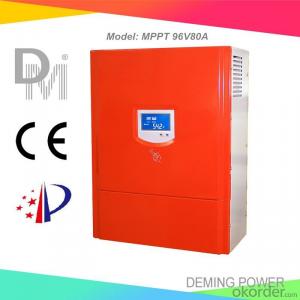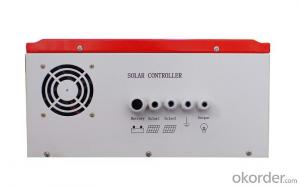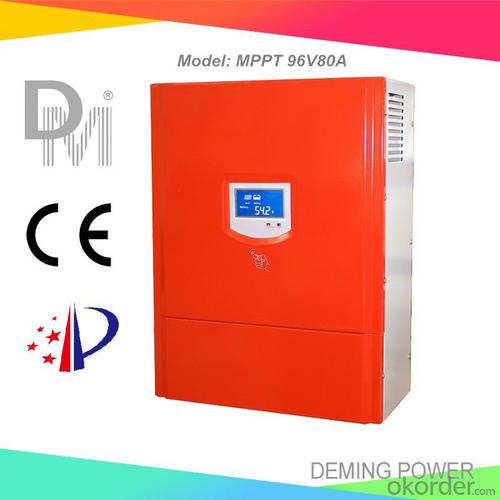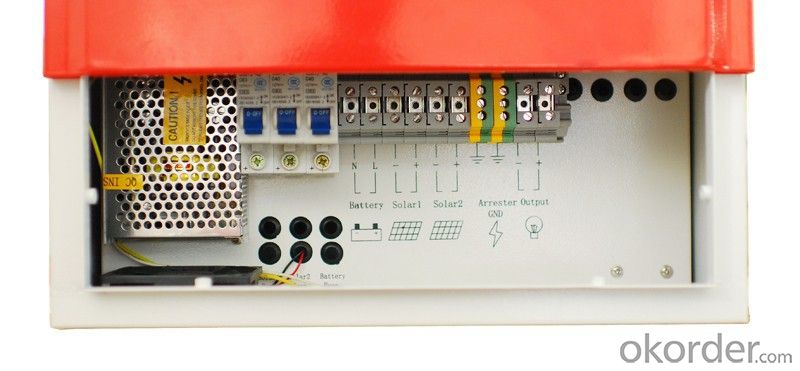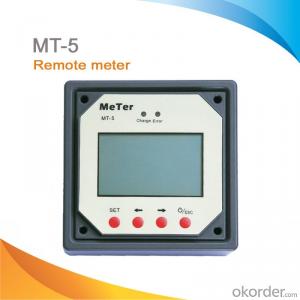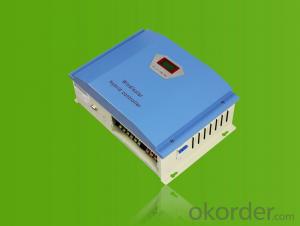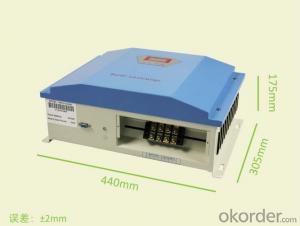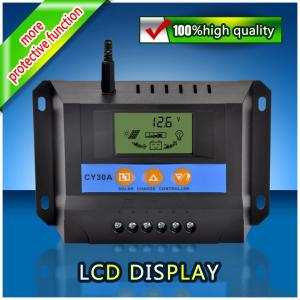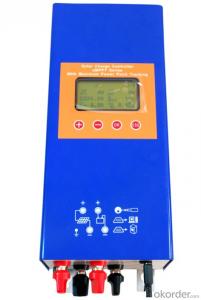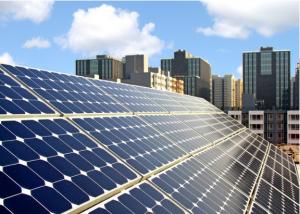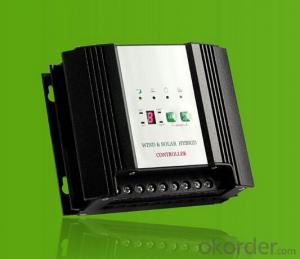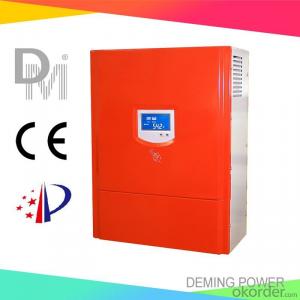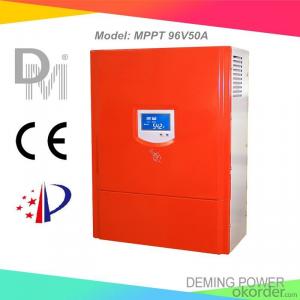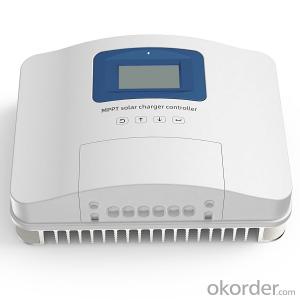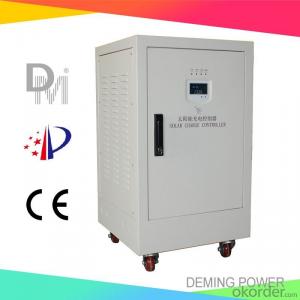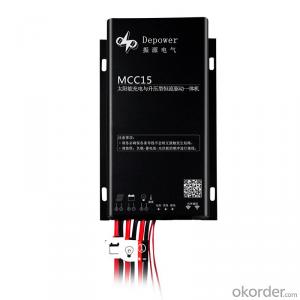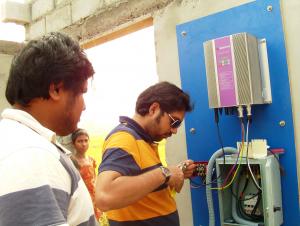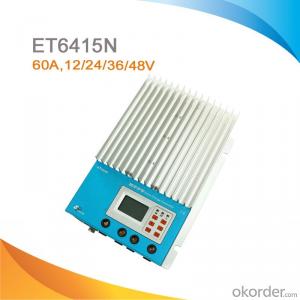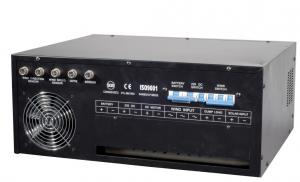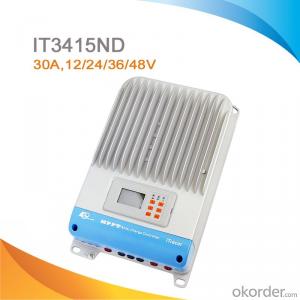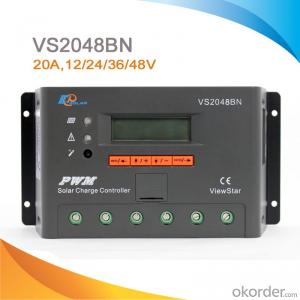10A MPPT Solar Charge Controller 96V 80A for Solar Power System
- Loading Port:
- Qingdao
- Payment Terms:
- TT OR LC
- Min Order Qty:
- 1 PCS
- Supply Capability:
- 1000 PCS/month
OKorder Service Pledge
OKorder Financial Service
You Might Also Like
Properties of the solar charge controller
1. Design for off-grid solar power system.
2. Applicable to different kinds of batteries.
3. Adopts MPPT technology (Maximum Power Point Tracking). The advanced tracking algorithm make the solar module operate at ideal voltage which the solar modules can produce the maximum available power.
4. Modular design with simple structure and easy maintenance.
5. Automatic power control function.
6. LCD display: Solar panel current, solar panel voltage, solar panel power, battery group voltage, charge current.
7. Perfect protection function: Solar reverse charge protection, Solar reverse connection protection, Battery reverse connection protection, Battery overcharge protection, Battery over current protection etc ,thus the system has higher reliability.
Technical parameters of the solar charge controller
Model | 96V80A | |||||
Battery group rated voltage | 96Vdc | |||||
PV Rated current | 80A | |||||
PV open circuit voltage | 400V | |||||
PV Max. power | 7680Wp | |||||
Input PV module road number | 1 | |||||
Function | MPPT charge mode, auto stop charge, auto recharge voltage; Protection: connecting contrary, over current, short circuit, over heat etc. | |||||
Display mode | LCD | |||||
Display content | solar panel voltage, solar panel current, solar panel power, battery voltage, charge current | |||||
MPPT DC voltage range | 80-116Vdc | |||||
Floating Charge Voltage (adjustable) | 110Vdc | |||||
Stop charge voltage | 116Vdc±1% | |||||
Recharge voltage | 108V±1% | |||||
Voltage drop between PV and battery | 1.5V | |||||
Max itself power consumption | 100mA-150mA | |||||
Work environment temperature | -30-60°C | |||||
Relative humidity | 90% No condensation | |||||
Applicable altitude | 3000m The rated power should be reduced when it is higher than 2000m | |||||
Noise (1m) | 40dB | |||||
Degree of protection | IP20(Indoor) | |||||
Cooling method | Forced air cooling | |||||
*Communication interface (optional) | RS485/USB/GPRS/Ethernet | |||||
*Temperature compensation(optional) | -4mv/°C/2V,-35°C~+80°C,Accuracy:±1°C | |||||
Product size (mm) | 480*370*160mm | |||||
Product Weight(kg) | 12kg | |||||
*Above parameter only for reference. Could be custom made to user specifications.
- Q: What is the role of a temperature sensor in a solar controller?
- The role of a temperature sensor in a solar controller is to measure the temperature of the solar panels or the surrounding environment. This information is then used by the controller to make decisions and adjustments, such as controlling the flow of energy or adjusting the angle of the panels, to optimize the performance and efficiency of the solar system.
- Q: Can a solar controller be used in a solar-powered submarine?
- Yes, a solar controller can be used in a solar-powered submarine. A solar controller helps regulate and optimize the charging of batteries from solar panels. In a solar-powered submarine, the solar controller can effectively manage the charging process and ensure the batteries receive the right amount of power from the solar panels, allowing for efficient and sustainable operation underwater.
- Q: What is the maximum load voltage in standby mode of a solar controller?
- When a solar controller is in standby or idle mode, the maximum load voltage refers to the highest voltage that can be applied to the load terminals. During this mode, the controller is not actively regulating the battery's charging or discharging, but it remains connected to the load. Typically, the maximum load voltage in standby mode of a solar controller matches the system voltage. For instance, if the solar system operates at 12 volts, the maximum load voltage in standby mode would also be 12 volts. Nevertheless, it is crucial to note that different solar controllers may have varying specifications and limitations. Therefore, it is essential to refer to the manufacturer's documentation or datasheet to determine the specific maximum load voltage in standby mode for a particular controller model. This information ensures that the connected load falls within the safe operating range, avoiding any potential harm to the controller or the load.
- Q: What are the advantages of using a solar controller in a solar system?
- There are several advantages of using a solar controller in a solar system: 1. Efficient energy management: A solar controller helps in efficiently managing the energy generated by the solar panels. It regulates the flow of electricity from the panels to the battery or the grid, ensuring that the system operates at its maximum efficiency. 2. Battery protection: Solar controllers prevent overcharging and deep discharging of the batteries. By monitoring the battery voltage and current, they ensure that the batteries are charged optimally and protected from damage, extending their lifespan. 3. System safety: Solar controllers protect the system from potential electrical faults, such as overvoltage or short circuits, which can cause damage to the panels or other components. This ensures the safety of the entire solar system. 4. Enhanced performance in varying weather conditions: Solar controllers have built-in features that allow them to adjust the charging parameters based on the weather conditions. This helps in maximizing the energy output of the solar panels, even in cloudy or low-light conditions. 5. Remote monitoring and control: Many solar controllers come with advanced features like remote monitoring and control. This allows users to monitor the performance of their solar system and make necessary adjustments remotely, providing convenience and flexibility. 6. Cost savings: By optimizing the charging process and preventing battery damage, solar controllers help in reducing maintenance and replacement costs. They also maximize the energy output, which can lead to significant savings on electricity bills. Overall, using a solar controller in a solar system provides numerous advantages, including efficient energy management, battery protection, system safety, enhanced performance in varying weather conditions, remote monitoring and control, and cost savings.
- Q: Can a solar controller be used with a solar-powered internet connection?
- Yes, a solar controller can be used with a solar-powered internet connection. A solar controller is designed to regulate the flow of energy from solar panels to a battery, ensuring efficient charging and preventing overcharging. In the case of a solar-powered internet connection, the solar controller would manage the energy flow from the solar panels to power the necessary components of the internet connection system, such as routers or modems.
- Q: Can a solar controller be used with solar-powered electric vehicle charging stations?
- Yes, a solar controller can be used with solar-powered electric vehicle charging stations. A solar controller is designed to regulate the flow of electricity from solar panels to the charging station, ensuring optimal charging efficiency and preventing overcharging or damage to the battery. It helps manage the power generated by the solar panels and directs it towards charging electric vehicles, making it an essential component for solar-powered charging stations.
- Q: Can a solar controller be used in a mobile solar power system, such as an RV or boat?
- Certainly, a solar controller can be utilized in a mobile solar power system such as an RV or boat. In fact, it is highly advisable to incorporate a solar controller in such systems to guarantee the effective and secure charging of the batteries. A solar controller, alternatively referred to as a charge controller, is engineered to regulate the transmission of solar energy from the solar panels to the batteries. Its primary objective is to prevent battery overcharging and over-discharging, as these can result in damage and reduce their lifespan. In a mobile solar power system like an RV or boat, where the solar panels are exposed to varying sunlight conditions and the batteries are consistently being charged and used, the significance of a solar controller becomes even more pronounced. It aids in optimizing the charging process by adjusting the voltage and current to align with the battery's requirements, thus maximizing the charging efficiency. Moreover, a solar controller of good quality will also incorporate additional features like temperature compensation and load control. Temperature compensation guarantees that the charging parameters are adjusted based on the surrounding temperature, thereby preventing any potential harm to the batteries. Load control enables the connection of supplementary loads to the system, such as lights or appliances, and ensures that they are directly powered by the solar panels without depleting the batteries. To summarize, a solar controller is an indispensable component in a mobile solar power system like an RV or boat. It plays a vital role in regulating the charging process, safeguarding the batteries, and optimizing the utilization of solar energy.
- Q: Can a solar controller be used in a hybrid solar power system?
- Yes, a solar controller can be used in a hybrid solar power system. A solar controller helps regulate the charging and discharging of batteries in a solar system, ensuring optimal performance and extending battery life. In a hybrid solar power system, where additional energy sources like wind or diesel generators are also used, a solar controller can still be utilized to manage the solar component of the system.
- Q: Can a solar controller be used with solar panels that are connected in parallel?
- Solar panels that are connected in parallel can indeed be used with a solar controller. In this configuration, the positive terminals of all the panels are connected together, as are the negative terminals. This setup allows for the combined voltage output of the panels while maintaining the same current output. The purpose of a solar controller is to regulate the charging process of batteries that are connected to the solar panels. It serves to prevent overcharging and damage to the batteries. To do so, the solar controller measures the voltage and current from the panels and adjusts the charging process accordingly. Regardless of whether the solar panels are connected in series or parallel, the solar controller can effectively monitor and regulate the charging process. It will measure the combined voltage and current from the parallel-connected panels and adjust the charging parameters accordingly. However, when connecting solar panels in parallel, it is crucial to ensure that the solar controller and the wiring used can handle the increased current. The total current output of the parallel-connected panels will be the sum of the individual panel currents, so the wiring and solar controller must be capable of handling this increased load. To conclude, solar panels connected in parallel can be used with a solar controller. The solar controller will continue to effectively regulate the charging process while ensuring optimal battery performance and longevity.
- Q: Can a solar controller be used with solar-powered indoor irrigation systems?
- Yes, a solar controller can be used with solar-powered indoor irrigation systems. The solar controller helps regulate the flow of electricity from the solar panels to the irrigation system, ensuring efficient power usage and preventing overcharging of batteries.
Send your message to us
10A MPPT Solar Charge Controller 96V 80A for Solar Power System
- Loading Port:
- Qingdao
- Payment Terms:
- TT OR LC
- Min Order Qty:
- 1 PCS
- Supply Capability:
- 1000 PCS/month
OKorder Service Pledge
OKorder Financial Service
Similar products
Hot products
Hot Searches
Related keywords
